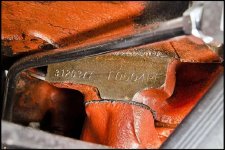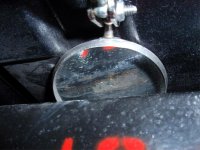Chevrolet began
stamping the VIN on Corvette engines and transmissions in 1960.
Before 1968, when a federal law required this serial number to be visible from the outside of the car, the Corvette's VIN was either located on the
steering column (1960–1962 models) or on a brace below the glove compartment (1963–1967 models).
For 1968 and newer Corvettes, the VIN is stamped either somewhere on the A-pillar supporting the windshield or on the dashboard, allowing you to read it through the windshield.
These simple digits reveal a wealth of information about your Corvette, including its manufacture year, the assembly plant where it was built, and the model. The last six digits of the VIN are the car's production number, which are unique for each Corvette.
For Corvettes built before 1960, VINs and engine stamps can give you clues about the correct engine. But no production number definitely mates one to the other. By comparing codes for the engine type and horsepower, the engine cast date, engine build date, and the car's build date, it is possible to determine if the engine is original or not. Proper documentation can help authenticate the matching numbers, but you may need an expert to help you validate how much of that pre-1960 car is actually original.
To find the
number on the engine pad, look for a stamped series of numbers near the right-hand cylinder head on the front of the engine (1960–1991 models) or on the rear of the engine (1992–1996 models).

This stamp includes codes outlining where the engine was built, the engine size, the casting date, the assembly date, and the serial number. Mecum Auctions, one of the largest auction houses for classic and collectible cars, requires sellers who claim matching numbers to verify four numbers on the block: engine casting number, engine casting date, engine assembly date, and the VIN or serial derivative.
If you are unable to locate the engine stamp, use a soft cloth to gently clean away any grease or dirt built up on the block. If you clean the engine and the number is still missing, it may have been sanded off during a motor rebuild.
The last six digits of the engine stamp are the serial number, which should match the production number on the Corvette's VIN. Cast date and assembly date (also called build date) are two other key clues to corroborate an original engine; both dates should be a few months prior to the build date on the body.
For a matching numbers Corvette, the most important thing is to have the original engine. Having other parts with the correct numbers can also be important if you want to maintain as high of a level of factory-correctness as possible.
On the transmission, the exact location of the code depends on the brand.
The code on many classic Saginaw, Muncie, and Turbo Hyrda- matic transmissions, for example, is
located on a stamp or plate on the right-hand side of the transmission case.
On this code, the first digits reveal the manufacturer, model year, and assembly plant. The final six numbers are the production sequence.
On a matching numbers' transmission, these six numbers will match the production number on the VIN and engine stamp.
The next step is to analyze the numbers on components like the alternator, carburetor, distributor, generator, starter, and water pump. Checking these codes should easily allow you to determine which parts have been replaced. Even if these numbers don't match the VIN, they should match the sequence of production. Because these numbers change through the years, use a source specific to your model to look up the correct part numbers for your Corvette.
Find the frame stamp
on top of the frame rail between the frame and the body under the
area near the driver's seat.
Hard to read without cleaning the top of the frame somehow and
possibly lifting the body.
Most of the time it can be done with a
small mirror between the body and top of the frame.




